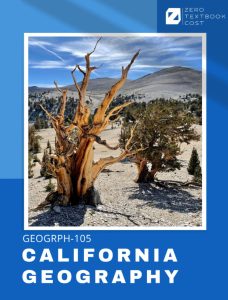[Geography] California Geography
Description of the Resource:
This is the first ever California Geography OER. There are at least 67 community colleges across the state that offer this course and this will be the first free textbook. Each chapter has at least three learning objectives, and will include a variety of innovative teaching/learning strategies:
- QR Codes
- Recent photos
- Case Studies
- Lecture Videos
- And more
This is a text that will showcase the unsung corners and stories of our state… the people, the music, the architecture, the food. I am hoping that this text will be setting a precedence in OER and ZTC education — inspiring faulty and authors to create living and humanized textbooks that inspire students to explore their backyards, and to explore their heritage and communities culture.
How This Resource Integrates Diversity, Equity, and Inclusion Principles and Practices:
This has been a project that I have been trying to undertake since entering full-time at my college, but the time and resources had not aligned until now. This text is my third formal OER text that I have published and one that I am extremely proud of, as I have had an opportunity to approach this text a bit differently than I have in the past, and that is by using the IDEAA lens. I wanted to create a text that was immersive, accessible, diverse, and showcased a few of the many unique and often unsung portions of the state.
I also want to say that another innovative practice is what stories are included in this text. Throughout the text, I dive a little deeper with what I am calling “case studies” where we can take a closer look. A great example is the unit entitled “Shade of California” where we discuss the stories, cultures, and people who have helped others (such as Delores Huerta) but I chose to write a case study on some of the people who had to endure tragedy — and we explore the Manzanar Internment Camp form WWII, as well as the people who lived there.
Throughout the text, I have also taken the opportunity to discuss indigenous people in each region, the language, their stories, and their importance to California’s history and geography.
Testimonials and/or Reviews:
“The textbook is easy to navigate and the diagrams and pictures are spot on. The chapters also build on each other. The five-minute video clips are a great addition to the text and give a sense of interactive learning.”
“I’m very much enjoying it and the way it pulls together the wealth of information. Pics and maps are great as well. I enjoy the way the Cultural Geography sections are not so much CA history, but CA cultural contributions oriented.”
“Also, I like the way the book is formatted. Particularly how it is set up in a way that as a student, I know what to expect in each chapter as far as the flow of what I’ll be learning. For example, how the goals and objectives of each chapter are set out in the beginning, helps me get a handle on what the learning expectations are for the week so when I am reading the chapter, I know what I need to focus on. Also, having a high level introduction section at the beginning of each chapter is also helpful. I like how there are photos or diagrams throughout the chapters and then every once in a while a QR code for a video link. ”
Tips, Tricks, and Advice from the Faculty Author(s) Regarding OER Creation:
At the end of the day, creating OER is not always easy. Some disciplines have had OER champions for over a decade, and to recreate content utilizing these premade resources allows authors an opportunity to pick the best of the best, like purchasing fruits and vegetables at the grocer — where you can choose from a variety of similar works to piece together the perfect text for you and your students.
In this case, there was really nothing out there that exhausted, and a lot of content needed to be interwoven and created. However, OER is a living thing, and will continue to change and adapt, and that is the real beauty of it. The fact that I can update a word, an image or a link on my master copy, and everyone using the book will immediately have their content updated for free is incredible. The fact that others will now use some, most or all of the work that I have created to better serve our students, to provide an equitable experience, to have immersive and experiential learning opportunity… these are things we and our student will never experience with a traditional publisher text, and that is what makes OER incredible.
As for tips, tricks and whatnot, I need to remember that that my work is never done. There will never be a final draft, and at first that was challenging. But not what I have used OER for a decade, I love the fact that these texts are never done growing, which allows me a chance to adapt, reinvent and review the content through both mine, and our students lenses.

